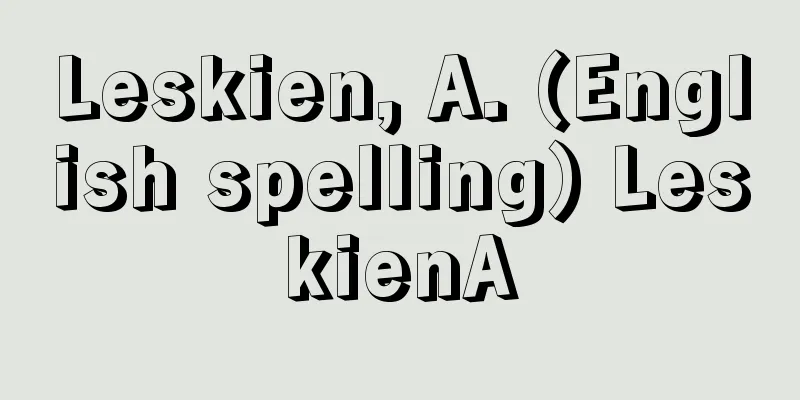High school - high school

|
A school for those who have completed six years of compulsory education in elementary school and three years of junior high school in Japan. Current senior high schools (high schools) are completely different in nature from the old senior high schools, and are upper secondary educational institutions that provide three years (full-time, or more than three years in the case of part-time and correspondence courses) following the so-called 6-3 system of compulsory education that was established as a result of the education system reform after World War II, and started in 1948 (Showa 23). Article 50 of the School Education Act (Act No. 26 of 1947) stipulates that "The purpose of high schools is to provide higher general education and specialized education in accordance with the physical and mental development of students, based on the foundation of education in junior high schools." In other words, the philosophy of high schools is as follows: (1) It is located at the upper secondary education stage of a single-track school system, open to all those who have completed nine years of compulsory education (six years of elementary school and three years of junior high school). (2) It provides education that takes into consideration the physical and mental development of students, rather than based on the needs of the nation or society. (3) Of the general education necessary for everyone, it provides both "higher" general education that follows "primary (elementary school)" and "secondary (junior high school)" and specialized education according to the student's subsequent career path. Initially, in order to realize this basic philosophy, However, after the Second World War, Japan was exhausted by the war and lacked the conditions to realize this ideal. In particular, after Japan gained complete independence with the coming into force of the Treaty of Peace with Japan in 1952, the country rebuilt itself on its own and in the process of implementing policies to achieve economic growth, the ideals and principles of high schools were significantly revised. The revisions are as follows: (1) Introduction of an examination system (high school entrance exams), (2) Emphasis on the needs of the nation and society over the needs of the students, (3) Restriction on coeducation for the sake of efficiency, (4) Separation of vocational high schools, part-time and correspondence high schools from full-time regular high schools, (5) Reduction of common education through the subdivision of departments and the adoption of a drastic system of elective subjects, (6) Switching from the elementary school district system to a junior high school district system and a university district system. Today, 96.4% (2008) of junior high school graduates go on to high school, and in this respect, the post-World War II ideal of being open to all citizens seems to have been realized. However, with the introduction of credit-based high schools (introduced in 1988), comprehensive departments (introduced in 1994), the creation of distinctive departments and courses (since 2002), and the introduction of secondary schools that provide a combined junior and senior high school education (1999), which replaced the traditional 6-3 system with a dual-track system, high school education has become so diverse that it is difficult to define "high school" in one word. As a result, a clear hierarchy has emerged between schools, and competition for entrance exams has intensified. On the other hand, however, far from acquiring a common education for the nation, various problems have arisen, such as a decline in motivation to study and a phenomenon of truancy among many students, including those who enrolled unwillingly. Against the backdrop of an increasingly diverse student population and rapid social changes, it is becoming increasingly difficult to define what "high school" is. [Toshiaki Kuwahara] "Eiji Kikuchi (ed.), "Comprehensive Research on High School Education Reform" (1997, Taga Publishing) " ▽ "Akiyuki Fujita (ed.), "New Style Schools: The Current State and Issues of Institutional Reform" (2006, Suuken Publishing)" ▽ "The Monthly High School Education Editorial Department (ed.), "A Book to Understand High School Reform: Its History and Future Prospects" (2006, Gakuji Publishing)" [Reference items] | | | | | | | |Unified | | |Source: Shogakukan Encyclopedia Nipponica About Encyclopedia Nipponica Information | Legend |
|
日本の小学校6年、中学校3年の義務教育を修了した者が進学する学校。現在の高等学校(高校)は、旧制高等学校とはまったく性格が異なり、第二次世界大戦後の学制改革により誕生したいわゆる六三制義務教育に続く3年間(全日制。定時制、通信制の場合は3年以上)を担当する後期中等教育機関であり、1948年度(昭和23)からスタートした。 学校教育法(昭和22年法律26号)第50条は「高等学校は、中学校における教育の基礎の上に、心身の発達に応じて、高等普通教育及び専門教育を施すことを目的とする」と規定する。すなわち、高等学校の理念は以下のとおりである。 (1)九年制義務教育(小学校教育6年、中学校教育3年)の修了者に広く開かれている、単線型の学校体系の後期中等教育段階に位置すること、(2)国家・社会の必要に応じてではなく、生徒の心身の発達を考慮した教育を行うこと、(3)万人に必要な普通教育のうち、「初等(小学校)」「中等(中学校)」に続く「高等」普通教育と、その後の進路に応じた専門教育とをあわせて施すこと。 当初は、この基本理念を実現するために、 しかし、戦争によって疲弊した第二次世界大戦後の日本は、この理想を実現する条件をあまりにも欠いていた。とりわけ1952年(昭和27)の対日講和条約発効により完全に独立して以後、独力で国を再建し、経済成長を図るための政策を遂行する過程で、高等学校の理念や原則が大幅に修正されることになった。修正された点は下記のとおりである。 (1)試験制度(高校入試)の導入、(2)生徒の必要よりも、国家・社会の必要を強調、(3)男女共学を効率性の面から抑制、(4)職業高校や定時制・通信制と全日制普通高校との分離、(5)学科の細分化や大幅な選択科目制の採用による共通教育の縮小、(6)小学区制から中学区制・大学区制への切り替え。 今日、中学校卒業者の96.4%(2008)が高等学校に進学し、この点では、全国民に開かれるという第二次世界大戦後の理想が実現されたかにみえる。しかし、単位制高校(1988年導入)、総合学科(1994年導入)、特色ある学科・コースの創出(2002年以降)、さらには従来の六三制を複線型化し中高一貫教育を行う中等教育学校の導入(1999年)など、「高等学校」はひとことでくくれないほど多様化している。こうしたことにより、学校間には歴然とした序列が生じ、受験競争が激化する。しかし一方では、国民の共通教養の修得どころか、不本意入学者など多数の生徒たちの学習意欲の減退や怠学の現象がみられるなど、さまざまな問題が生じている。多様化する生徒と急激な社会変化を背景に、ますます「高等学校」の定義づけをむずかしくしている。 [桑原敏明] 『菊地栄治編著『高校教育改革の総合的研究』(1997・多賀出版)』▽『藤田晃之著『新しいスタイルの学校――制度改革の現状と課題』(2006・数研出版)』▽『月刊高校教育編集部編『高校改革がわかる本――その歴史とこれからの展望』(2006・学事出版)』 [参照項目] | | | | | | | | | | |出典 小学館 日本大百科全書(ニッポニカ)日本大百科全書(ニッポニカ)について 情報 | 凡例 |
Recommend
Odin's Proverbs - Odin's Proverbs
... <When a fool gets wealth or the love of a ...
Arnold Wesker
British playwright. Born to Jewish immigrants of ...
Aemon
...commonly known as the Balkan Mountains. Its an...
Essa historical materials
A collection of chronological historical materials...
The Great Japanese Pirates of the Jiajing Period
The Wokou were pirates who operated along the coas...
Tayyib Sāliḥ (English spelling)
…Tawfiq al-Hakim, Taha al-Husayn, and others publ...
Great Buddha - Daibutsu
A giant Buddha statue. A general term for Buddha ...
Tamanrasset (English spelling)
Formerly known as Fort-la-Prine, this oasis town i...
Jie - Butt
Ancient China, summer mosquito The last king of th...
Revolutionary situation
… [The Political Process of Revolution] The direc...
Imakita Hongcheon
Year of death: January 16, 1892 (Meiji 25) Year of...
Thomas, E. Donnall
Born March 15, 1920 in Mart, Texas [Died] October ...
Yatsushiro Plain - Yatsushiro Heiya
The southern half of the Kumamoto Plain is surrou...
catabolism
...Thus, although the efficiency of energy conver...
meatus acusticus externus
…There are six auricular muscles attached to the ...









